Arizona is the state with the largest bee diversity in the US. More than 1.300 species of bees are found here. The Sonoran Desert alone is home to more than 600 species of bees.
Arizona is home to a considerable diversity of bees from the estimated 5.000 species found in the US. The following bees are the most popular in the state.
Table of Contents
1. Western Honey Bee
The Western Honey Bee (Apis mellifera) is the most common species in Arizona. This species is common around the world with a very wide distribution from the 17th century to this day.
While there are 26 similar subspecies of Western Honey Bees, these can be identified by orange-yellow rings, black bands, and a hairy thorax.
Bees of the genus grow largest when they’re queens. Western Honey Bee queens grow to 20mm compared to males known as drones who only grow to 17mm. Worker Western Honey Bees grow to a maximum size of 15mm.
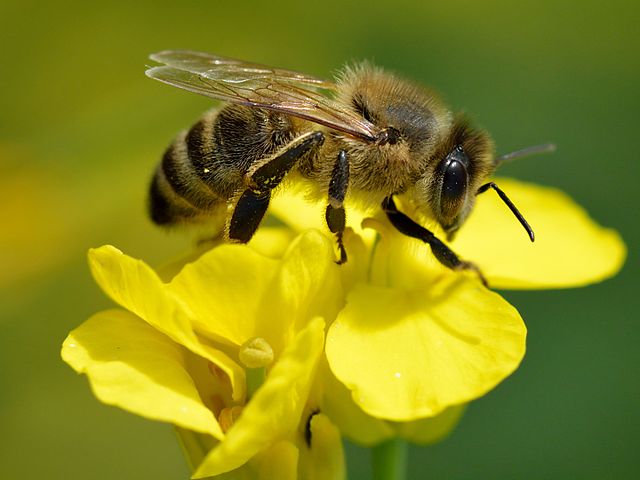
These bees are known to live in wetlands and drylands, provisioned there’s sufficient water and food around.
Nesting in cavities, these bees have a major pollination role. They also produce honey.
Honey from these bees is known for being made from the pollen of various flowering plants. It mainly contains fructose and glucose.
2. Western Carpenter

Also known as the California Carpenter, the Western Carpenter Bee (Xylocopa californica) is native American.
They are seen in the forests and meadows of Arizona. These bees are easy to recognize as they’re mostly black.
Females are darker than males who also tend to have a few light hairs. These bees have black wings and black antennae.
Western Carpenter Bees are commonly seen in late summer.
They are known for their positive pollination role in woodlands and with flowering plants found in deserts.
3. Sonoran Bumble Bee

Sonoran Bumble Bees (Bombus sonorus) are native to the Sonoran Desert. They are recognized by their large black and yellow bodies.
These bees grow up to 18mm.
Sonoran Bumble Bees look similar to other black and yellow bees but they can be distinguished by flight season.
They are very active in late summer and the fall, unlike most other bumblebees active in spring and summer.
These bees live in nests established by a queen. Both nests and queens survive up to a year.
Unlike other honey-making bees, the Sonoran Bee nest isn’t known for clear cast separation.
Most bees contribute to collecting pollen and to maintaining the nest.
4. Valley Carpenter Bee

Valley Carpenter Bees (Xylocopa sponsoring) are common in Arizona and nearby states. They are known for their all-black body.
These bees have a blackhead, black wings, and black hairy legs.
Valley Carpenter Bees are efficient pollinators with their hairy legs. These bees have been shown to visit up to 16 various flowers per minute with a large pollination role.
Solanaceae are among its preferred pollination flowers but the species visit multiple other flowers.
These bees aren’t dangerous as they rarely sting. Male Valley Carpenter Bees don’t have stingers and can’t sting at all.
5. Hunt’s Bumble Bee

Hunt’s Bumble Bees (Bombus hunt) are known in agriculture as efficient tomato pollinators.
The species is also known for visiting rabbitbrush and thistle plants.
High adaptability also describes the species in terms of habitat. They live in arid areas of Arizona and further elevation in volcanic mountains in Mexico.
Hunt’s Bumble Bee has black and yellow coloring. It has orange-red markings on its back.
6. Ligated Furrow Bee

Ligated Furrow Bees (Halictus ligatus) are known for their positive role in pollinating Arizona flowers.
The species pollinates flowers via foragers. It prefers high-protein pollen even if it visits various flowers each day.
These eusocial bees live in well-drained in-ground nests.
Queens lead a colony but they often enter conflicts with other female bees as high levels of aggression are characteristic of Ligated Furrow Bees.
7. California Digger Bee
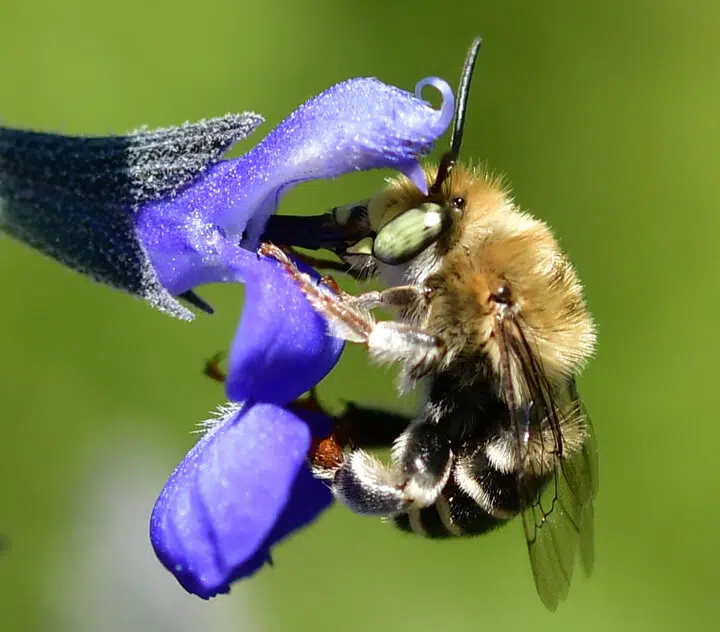
These large bees (Anthophora californica) are identified by a golden hairy thorax and a shiny black and white banded abdomen.
Male California Digger Bees have also been shown to poses leg adaptations similar to blades. These help them hold on to the female while mating.
The species digs nests in the ground. Males wait for females at the nest’s entrance to mate.
Both male and female California Digger Bees drink flower nectar directly.
These bees are mostly seen in the fall when they forage pigeonberry (a perennial herb) and Silver-leaf nightshade flowers.
8. Honey-tailed Striped Sweat Bee
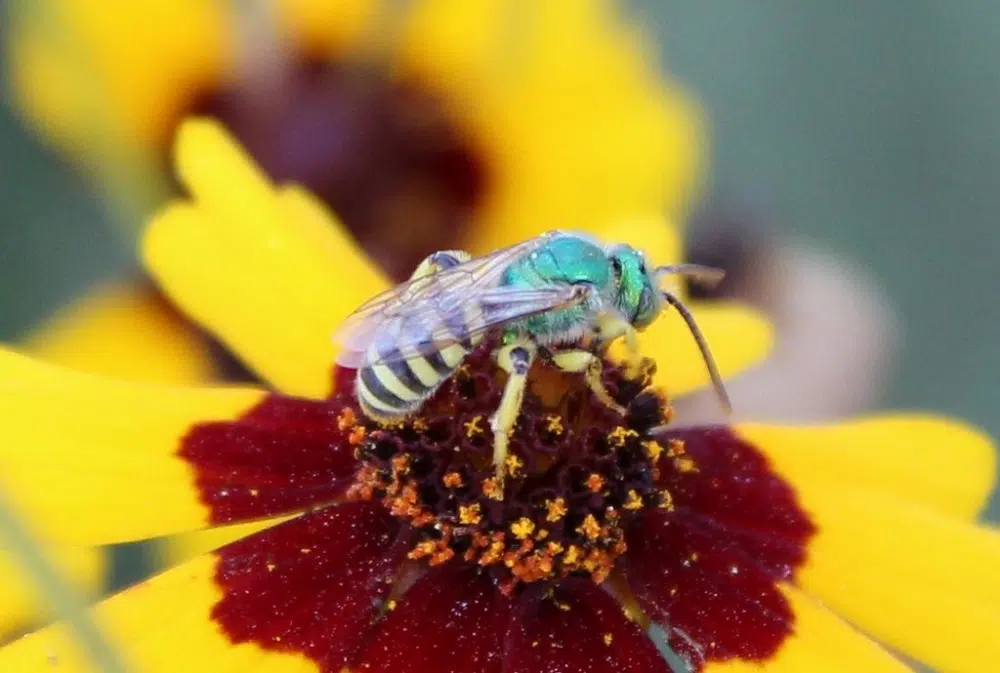
These bees (Agapostemon melliventris) are known pollinators of decorative trees in Arizona gardens and parks.
Male and female bees have similarities as well as differences in appearance. Both have a metallic green thorax.
Female bees have golden bands and black bands on the abdomen. Male bees have yellow and black bands on the abdomen.
These bees have a limited 1-year lifespan. They are seen congregating or foraging in groups.
As part of the sweat bee group, these bees are attracted to human sweat but they aren’t aggressive towards people.
9. Tripartite Sweat Bee
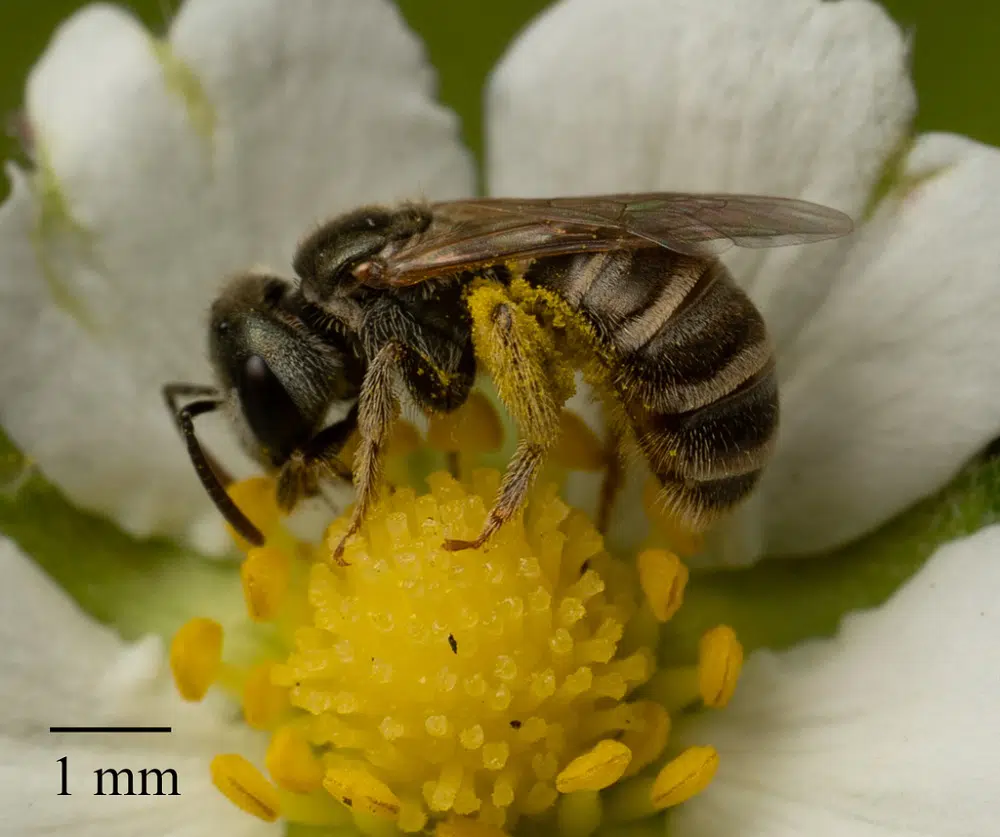
This species (Halictus tripartitus) is part of the Halitcidate genus.
It has brown antennae and a brown head. The thorax is also brown whole the abdomen is light brown with yellow bands.
Its wings are transparent brown.
Short yellow hairs are found across its body and its legs.
10. Cellophane Bees

Cellophane Bees (Genus Colletes) have varying sizes. Most adult bees of the species measure anywhere between 7 and 16mm.
The bees are known for black and white banding on the abdomen.
They have clear wings and are known for nesting in the ground.
Nests are only a few inches deep which means these bees are often seen from outside. Their head is also white and black, similar to their pointed gasters.
11. California Digger-cuckoo Bee
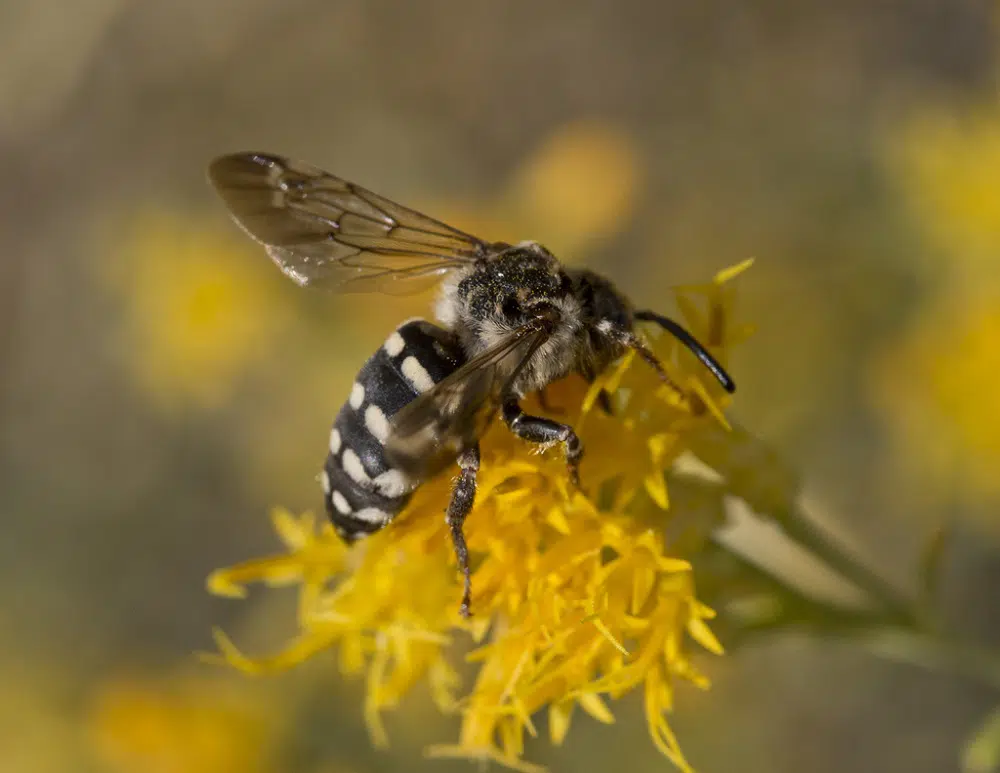
California Digger-cuckoo Bees (Brachymelecta californica) have similar pointed black and white gasters to Cellophane Bees.
These bees are widespread throughout the state. They are differentiated from other black and white abdomen bees by the extra presence of pale yellow hairs on the abdomen.
Part of the Brachymelecta genus, these bees were once believed to be the rarest species in North America.
It was also the only known Brachymelecta species that is today found all across the US.
12. Barrel Cactus Longhorn
This species (Svastra duplocincta) is common in Arizona, Texas, and Northern Mexico.
Most reported Barrel Cactus Longhorn bee colonies are situated in Phoenix, Tucson, and Flagstaff.
The species is identified by golden-black coloring. The thorax is hairy golden while the abdomen is golden-black.
These hairy bees are excellent pollinators of Compact Barrel Cactus flowers.
13. Morrison’s Bumble Bee

With a diminishing status across states such as California, Morrison’s Bumble Bee (Bombus morrisoni) is still seen in Arizona.
This species is characterized by an almost entirely yellow-golden body. The last segment of its abdomen is black, as are its legs.
The bumble bee is known for nesting in various locations such as in the ground in existing cavities or above the ground.
It’s considered a common pollinator or specific flowering plants such as thistle, rabbitbrush, and milkweed.
14. Peridot Sweat Bee
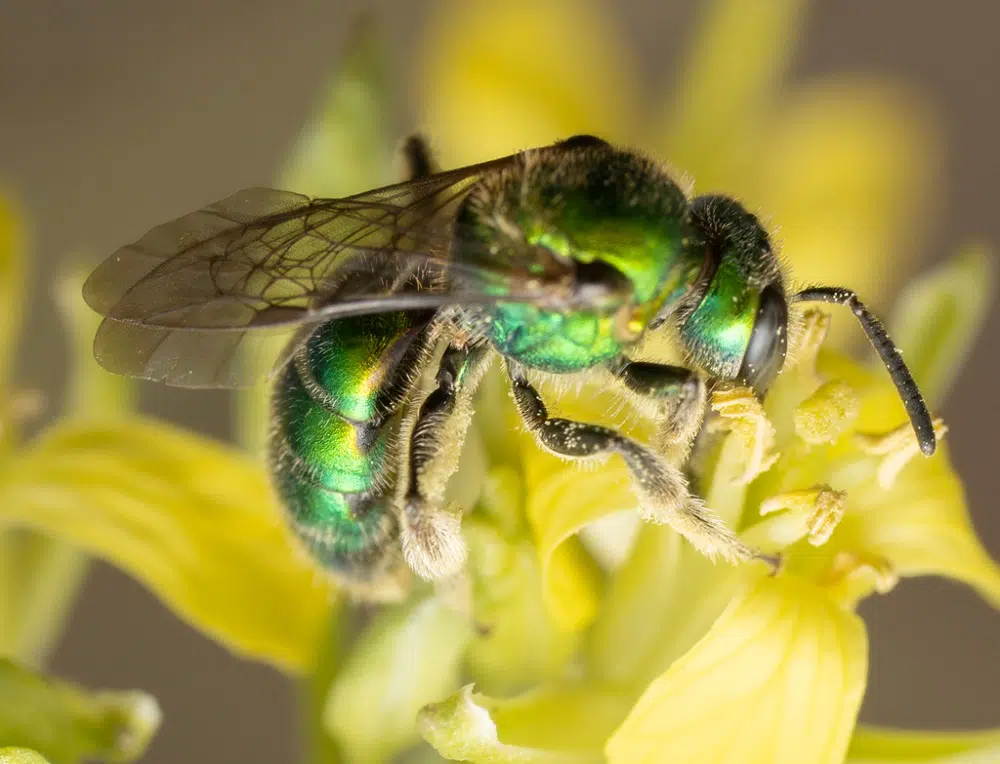
These bees (Augochlorella pomoniella) are instantly recognized by their metallic green body color. These colors often have golden shades which help the species stand out.
Smaller than other Arizona species, these bees grow to 10mm on average. Peridot Sweat Bees are also commonly seen to be as small as 7mm (males).
The species is known for nesting in various habitats across the states. Woodlands and dry soils are preferred for building nests.
These bees are known for generally using existing cavities that they further excavate to create underground nests.
Some of these nests are compromised by multiple chambers, used to lay eggs.
These bees are common pollinators of decorative flowers. Preferred visited flowers include wild roses, alfalfa, and goldenrod.
15. Black-tailed Bumble Bee

The Black-tailed Bumble Bee (Bombus melanopygus) gets its name from its all-black abdomen contrasted by a golden yellow-brown thorax.
These hairy bees are known as excellent pollinators with very good adaptability skills.
Black-tailed Bumble Bees are found across multiple habitats within Arizona which includes urban environments.
Bees of the species are mainly known for nesting underground but they can find individual shelters even above the ground.
Common benefits of these bees include pollination roles for willows, lilacs, and wild buckwheat.
16. Nevada Bumble Bee

Unlike its name suggests, the Nevada Bumble Bee (Bombus nevadensis) is widespread throughout the US, including Arizona.
These bees have dense yellow and black fur which helps pollination. Physical differences between males and females are seen apart from size.
Females have a black head while males have a black head with yellow markings.
Females grow up to 17mm while males grow up to 14mm.
These bees are mostly seen in open prairies. They typically look for food sources such as thistle and penstemons in prairies.
17. Urbane Digger Bee
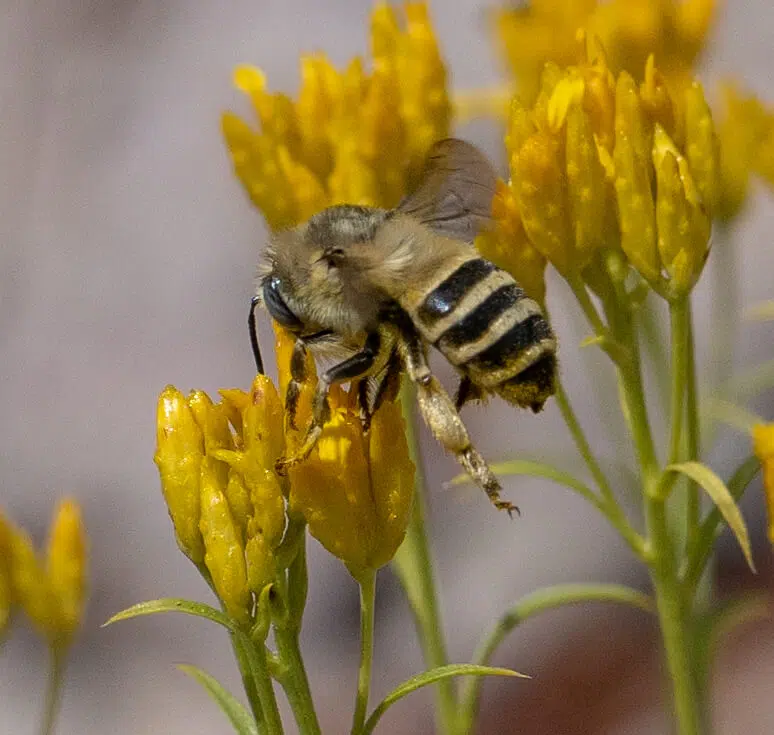
These furry bees (Anthophora urbana) are identified by yellow and black body coloring. They have black legs with yellow hairs, black wings, and black antennae.
Urbane Digger Bees are known for nesting individually in the ground. They create clusters of individual nests that are a few inches deep directly in the ground.
Male bees are seen arising late in the season when they await next to the underground nests to mate with a female.
18. Red-legged Centris
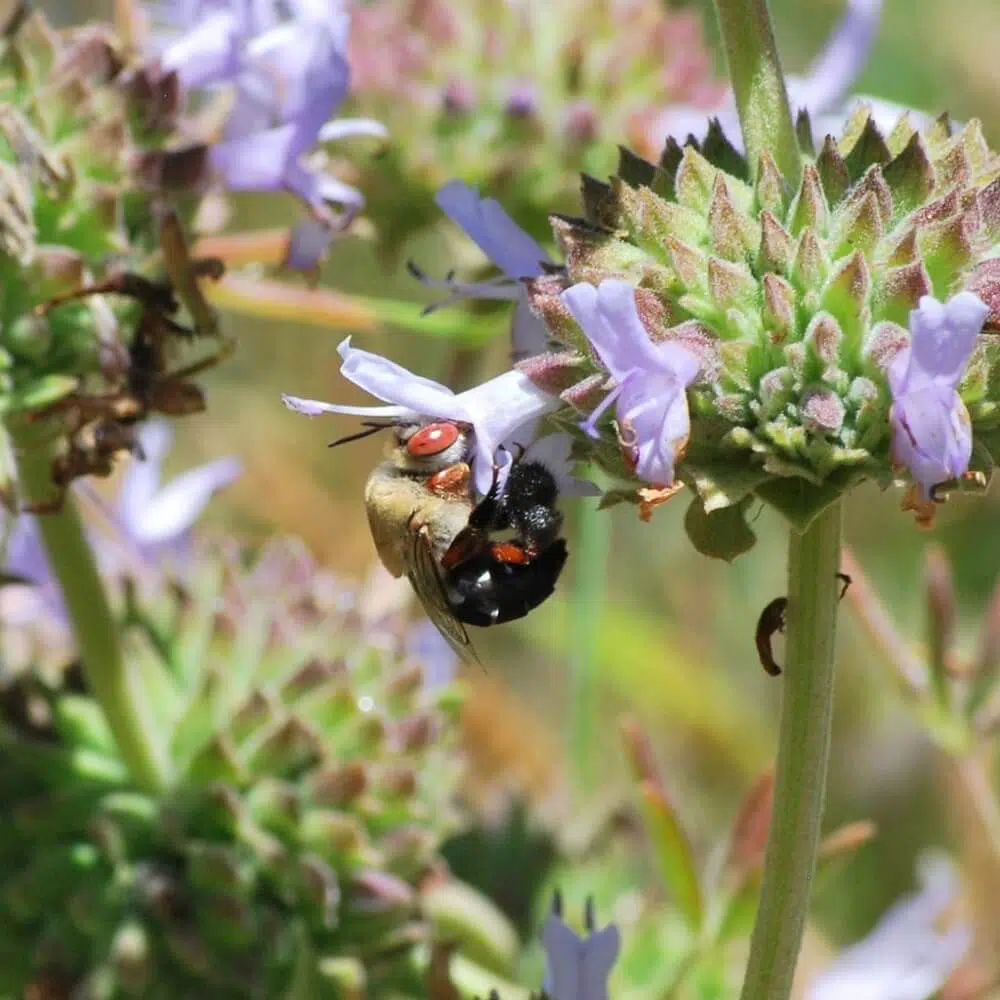
This rare species (Centris rhodopus) is found in Arizona as well as in Central America.
It has a fury yellow thorax and a black abdomen. These bees get their name from their red legs.
However, the species further stands out due to its large red eyes.
19. Pallid Desert-Digger
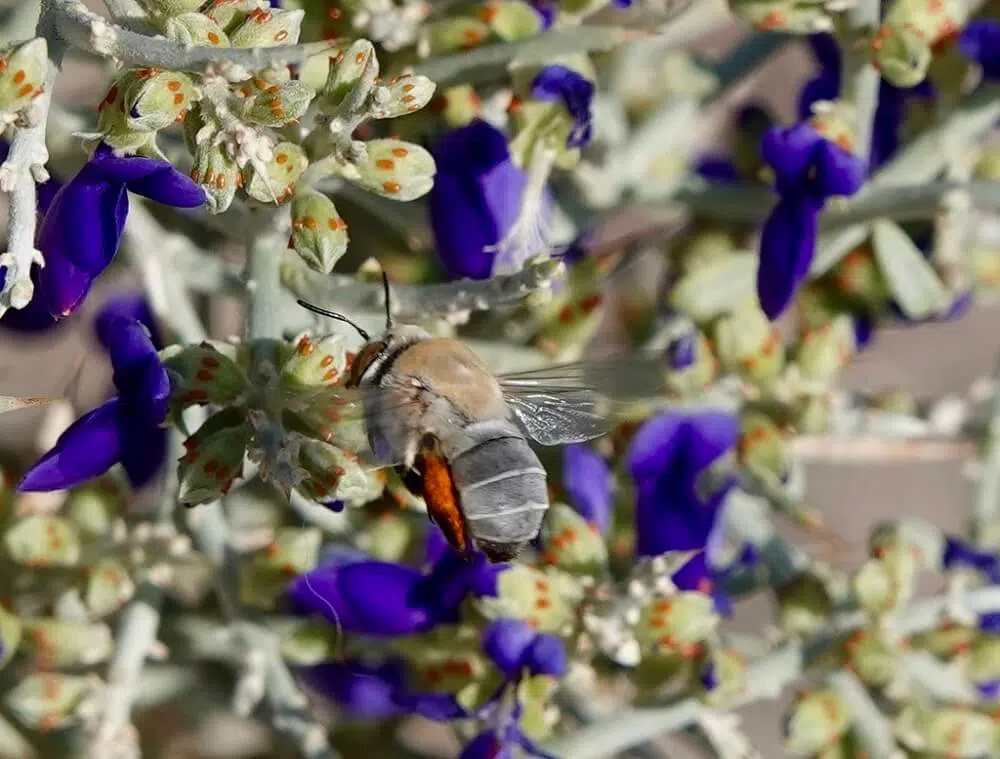
These bees (Centris pallida) are also known as Desert bees. They are very common in Arizona and Nevada.
Unlike most other bees in the state, Pallid Deser-Digger bees pollinate cacti and other plants of the desert such as desert willow.
The bees have been extensively studied for their communication based on pheromones.
Virgin females release a pheromone that attracts females.
This pheromone is released before females first emerge from an underground nest. This is the reason males are often seen patrolling the areas around these underground nests.
20. Spotted Woolcarder

This solitary bee species (Anthidium maculosum) is known for having a wide short body of black and yellow color.
Orange hairs are also seen on the head of the male bee.
Spotted Woolcarder bees are known for polyandry, or the capacity of the female to mate with multiple mates at the same time.
The size of these bees is important in determining their influence. While not eusocial, Spotted Woolcarder male bees show territorial defense in areas with multiple females.
21. Oblique Longhorn
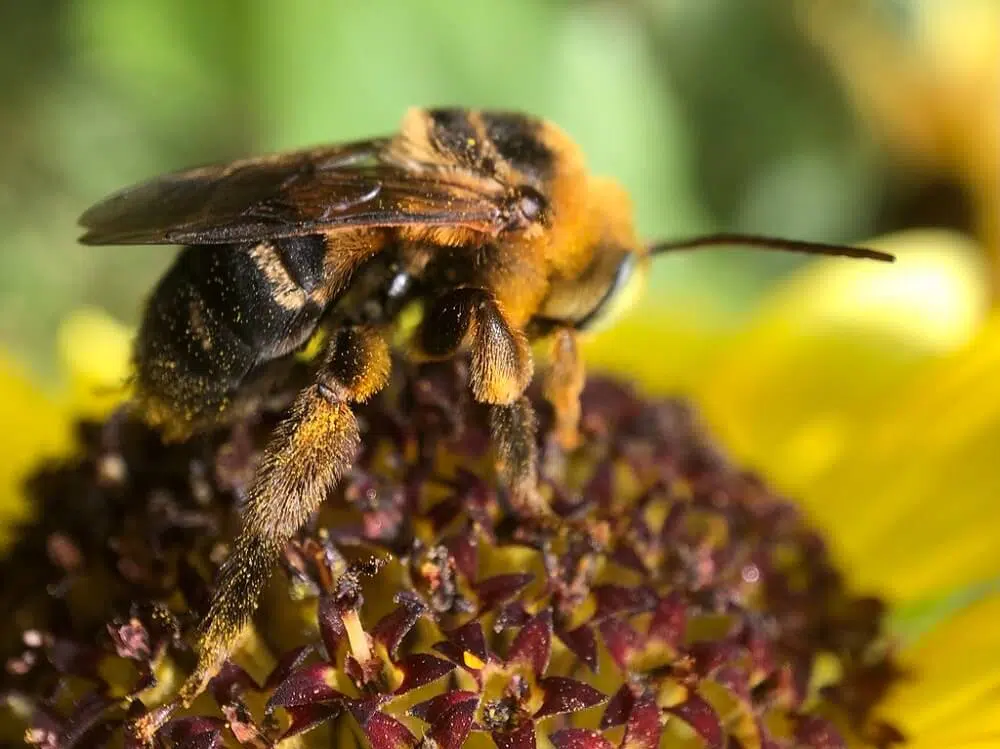
Also known as the Sunflower bee, the Oblique Longhorn (Svastra obliqua) is a US native species.
Identification is based on its large size of up to 19mm for females and up to 15mm for males.
These are large orange bees and known sunflower pollinators.
They also pollinate gaillardia flowers and asters, even if they are general pollinators.
22. Parosela Long-horned Bee
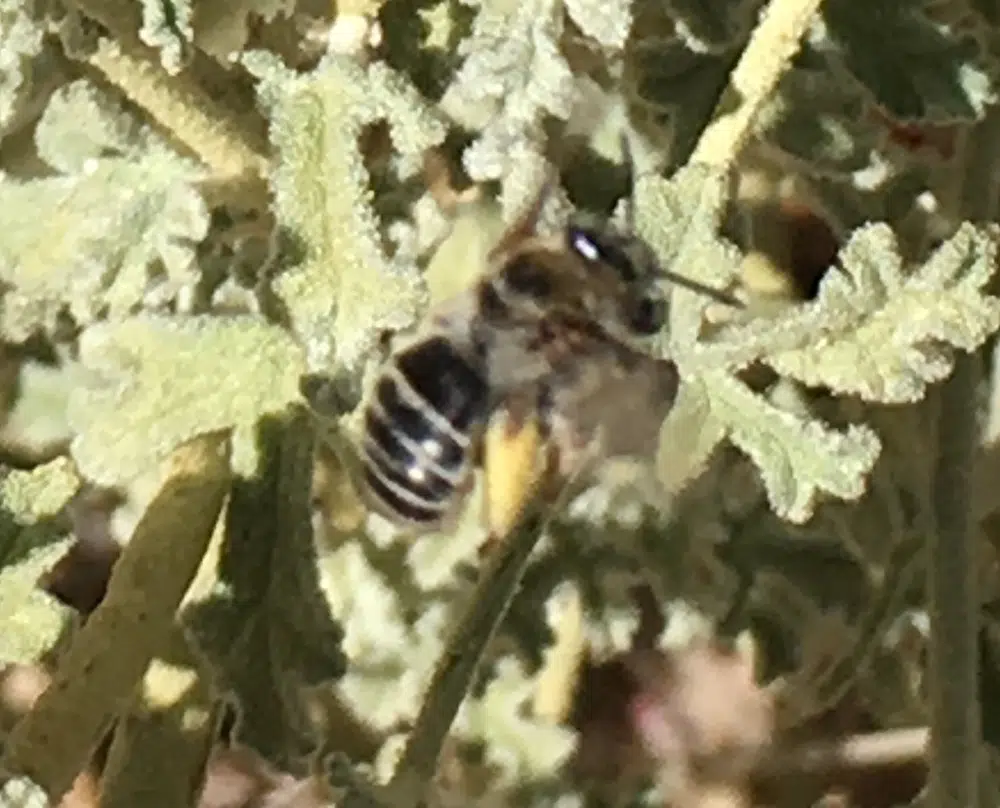
This multi-colored bee species (Melissodes paroselae) is native to North and Central America.
It’s found in Arizona where its red marks help it stand out compared to other native species.
With an average size of 9mm, the Parosela Long-horned Bee is one of the small species in the state.
They show yellow or white and black bands across the body. Legs, antennae, and wings are red.
23. Lasioglossum sisymbrii

This species is known for its black-white banded furry body.
Transparent white wings are characteristic of these native bees. Their habitat expands throughout the Western part of the US as well as into Mexico.
Part of the Halictidae family, these bees aren’t as common in Arizona as in California or Nevada.
Still, they have a major role in pollination as general pollinators.
Lasioglossum sisymbrii are eusocial bees that live in colonies.
24. Calliopsis subalpina
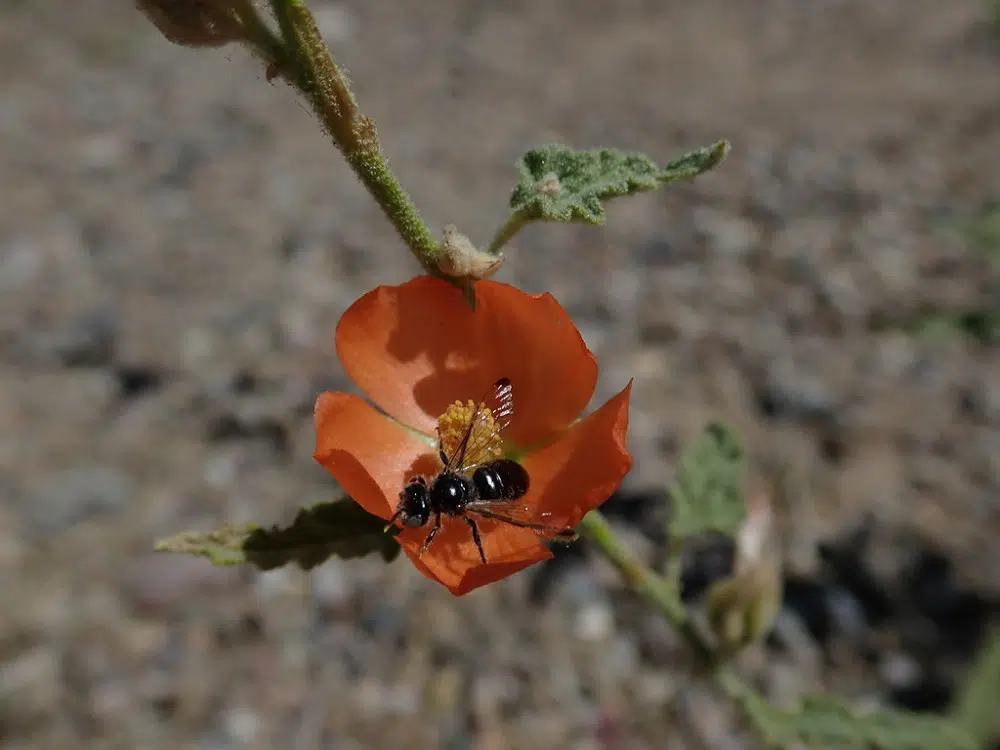
Part of the Andrenidae family, Calliopsis subalpine are known for nesting in loose ground.
They represent one of the few all-black shiny bees in Arizona. They only exhibit bright coloring on the antennae.
Yellow marks are seen at the top of the antennae for this species.
These bees are also nocturnal. They are part of a small group of Vespertine Arizona bees.
With enlarged ocelli, these bees are technically foraging in the evening.
Further Reading: